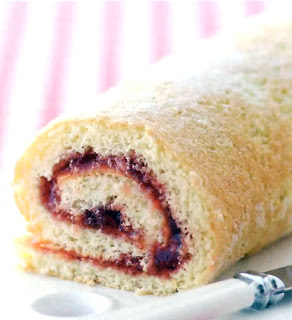These type of rolled cakes have been made since Elizabethan times in one way or another (though using yeast-based dough). However, it was the development of baking powder and the advent of modern sponge cakes during Victorian times that led to the evolution of the modern Swiss Roll (see this page for a classic Victorian Swiss roll recipe).
Swiss Roll (Jelly Roll)
Invented in the Victorian era, the Swiss roll (or Jelly Roll in America) is a thin sheet of sponge cake topped with jam (jelly) thats rolled tightly and arranged so that the seam is downmost before being dusted with sugar, sliced and eaten typically at tea time.
The original Victorian Swiss (Jelly) roll used egg whites rather than baking powder as the raising agent, but in all other respects was the same as its modern equivalent, which I present below.
Ingredients:
75g (3 oz) plain 00 flour3 medium eggs
75g (3 oz) caster sugar
200g (1 cup) strawberry jam (or your favourite jam or marmalade — apricot is good)
caster sugar, to dust
Method:
Sift the flour into a bowl and set aside. In another bowl, combine the eggs and caster sugar. Whisk for about 10 minutes, or until the mixture is pale, thick and creamy and the whisk when removed leaves a trail.With a large metal spoon, gradually and gently fold the flour into the egg mixture until evenly combined. Gently pour this batter into a Swiss (jelly) roll tin or shallow baking tin (about 33 x 23cm [13 x 9 in]) lined with baking parchment.
Lightly level the surface of the batter then transfer to an oven pre-heated to 180ºC (350ºF, Gas Mark 6) and bake for between 8 and 10 minutes or until well risen, golden brown and firm to the touch.
Whilst the Swiss roll is baking, sit a large piece of baking parchment on your work surface and sprinkle this with caster sugar. As soon as the cake comes from the oven turn it out onto the paper, removing the parchment that the Swiss roll was cooked in. Trim the edges of the cake neatly then spread quickly with the strawberry jam.
Roll the cake up from the short end, using the sugared parchment to help so that the jam is in the middle and the cake is fully enclosed in the parchment. Still wrapped in the parchment turn the cake so that the seam side is on the bottom then set aside to cool (being wrapped in the parchment will help it keep its shape).
When cold, either store or slice into rounds and serve.
As variants, why not add lemon zest to the cake mix and use lemon curd as a filling, or substitute 25g (1 oz) of the flour with cocoa powder and fill with cream or buttercream for a chocolate version.











No comments:
Post a Comment